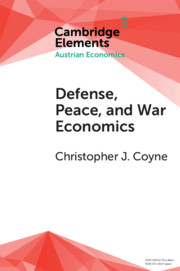Element contents
Defense, Peace, and War Economics
Published online by Cambridge University Press: 28 February 2020
Summary
Information
- Type
- Element
- Information
- Series: Elements in Austrian EconomicsOnline ISBN: 9781108668873Publisher: Cambridge University PressPrint publication: 02 April 2020
References
Accessibility standard: Unknown
Why this information is here
This section outlines the accessibility features of this content - including support for screen readers, full keyboard navigation and high-contrast display options. This may not be relevant for you.Accessibility Information
- 13
- Cited by
